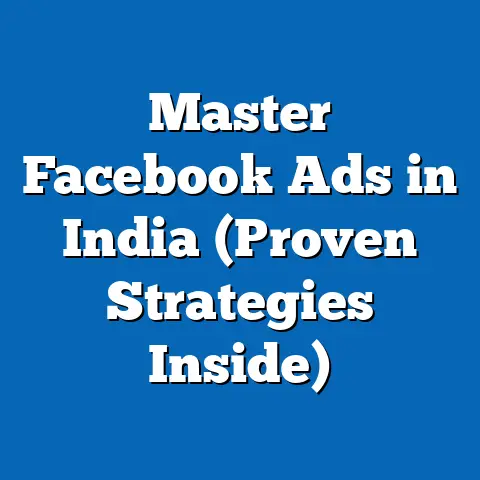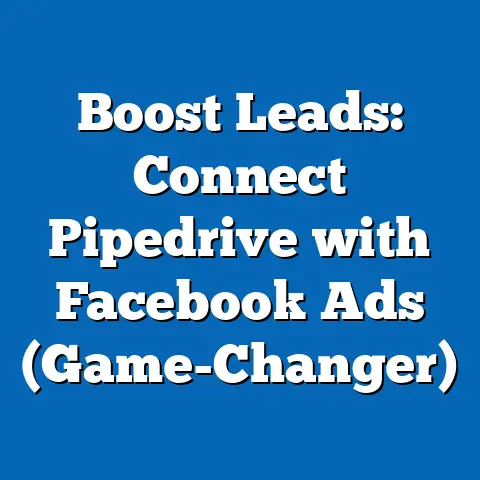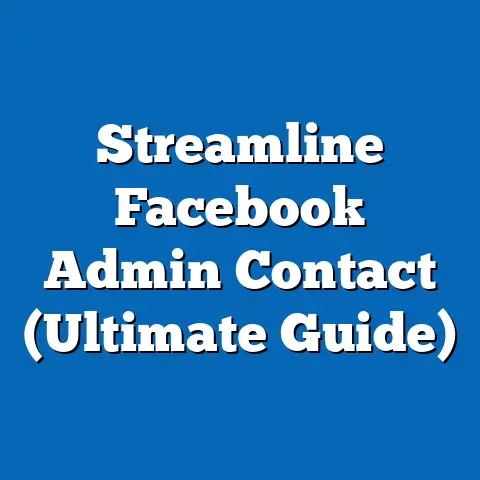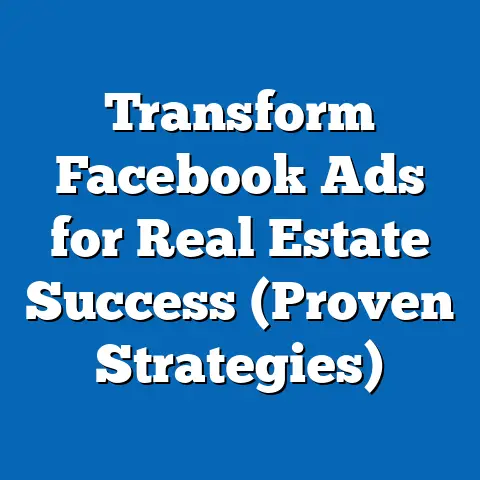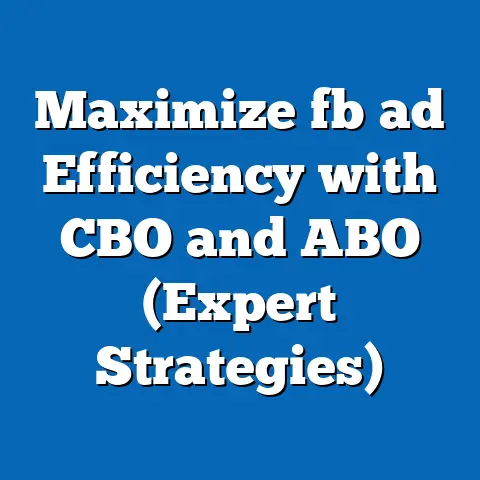Post Political Ads on Facebook? (Essential Guide)
The world of political campaigning has undergone a seismic shift in recent years, and at the epicenter of this transformation lies Facebook. Gone are the days when television commercials and newspaper ads reigned supreme. Today, digital platforms, especially Facebook, have become the battleground for hearts and minds, reshaping how political messages are crafted, delivered, and received.
I’ve witnessed firsthand how Facebook’s innovative targeting capabilities have leveled the playing field, allowing political advertisers to reach specific demographics with unprecedented precision. This isn’t just about broadcasting a message to the masses; it’s about engaging in personalized conversations with potential voters, addressing their specific concerns, and building genuine connections.
Social media, and Facebook in particular, plays a pivotal role in shaping public opinion and mobilizing voters. It’s a space where ideas are debated, narratives are constructed, and movements are born. Political campaigns that understand and effectively leverage this dynamic environment have a distinct advantage.
Think about the 2008 Obama campaign, which masterfully used social media to connect with young voters and build a grassroots movement. Or consider the more recent campaigns that have harnessed the power of data analytics and micro-targeting to deliver hyper-personalized messages to swing voters. These are just a few examples of how Facebook has revolutionized political advertising.
Key innovations in technology, such as AI-driven analytics and sophisticated data mining techniques, have further amplified Facebook’s impact. These tools allow campaigns to analyze vast amounts of data, identify key trends, and optimize their messaging for maximum impact.
Key Innovations Transforming Political Advertising
Here’s a quick look at some of the game-changing technologies that have redefined political advertising on Facebook:
- AI-Driven Analytics: Analyzing voter sentiment and predicting behavior with greater accuracy.
- Micro-Targeting: Delivering personalized messages to specific demographics based on interests, behaviors, and demographics.
- Data Mining: Uncovering hidden patterns and insights from vast datasets to refine campaign strategies.
- Automated Ad Optimization: Using algorithms to automatically adjust bids, targeting, and ad creatives to maximize performance.
- Real-Time Engagement Tracking: Monitoring and responding to voter feedback in real-time to shape the narrative and address concerns.
Let’s dive in and explore how you can leverage Facebook to build a winning political campaign.
Section 1: Understanding Facebook Ads
Before diving into the specifics of political advertising, it’s crucial to understand the fundamentals of Facebook ads. I’ve spent years working with the platform, and I can tell you that mastering the basics is essential for success, regardless of your political affiliation or campaign goals.
Overview of Facebook Advertising
Facebook advertising is a powerful tool that allows you to reach a massive audience with targeted messages. With billions of active users, Facebook offers unparalleled reach and engagement opportunities.
How Facebook Ads Work:
Facebook ads operate on an auction-based system. Advertisers bid for the opportunity to display their ads to specific users based on various targeting criteria. When a user visits Facebook, the platform runs an auction to determine which ads will be shown to that user. The winning ads are displayed based on a combination of bid amount, ad quality, and relevance.
Ad Formats:
Facebook offers a variety of ad formats to suit different campaign objectives. Here are some of the most common:
- Image Ads: Simple and effective, image ads feature a single image and accompanying text. They’re ideal for showcasing products, services, or events.
- Video Ads: Engaging and immersive, video ads capture attention and convey complex messages in a dynamic format. They’re perfect for storytelling, product demonstrations, and brand building.
- Carousel Ads: Versatile and interactive, carousel ads display multiple images or videos in a scrollable format. They’re great for showcasing a range of products, highlighting different features, or telling a story in multiple parts.
- Collection Ads: Designed for e-commerce, collection ads feature a main image or video along with a selection of related products. They provide a seamless shopping experience for users.
- Lead Ads: Streamlined and convenient, lead ads allow users to submit their contact information directly within Facebook. They’re ideal for generating leads, collecting email addresses, and building your audience.
The Facebook Ads Manager:
The Facebook Ads Manager is your command center for creating, managing, and analyzing your ad campaigns. It provides a comprehensive suite of tools for targeting, bidding, budgeting, and tracking performance. I’ve spent countless hours navigating the Ads Manager, and I can confidently say that it’s an indispensable resource for any serious advertiser.
Key Features of the Ads Manager:
- Campaign Creation: Set up new campaigns with clear objectives, such as driving website traffic, generating leads, or increasing brand awareness.
- Ad Set Configuration: Define your target audience, set your budget and schedule, and choose your bidding strategy.
- Ad Design: Create compelling ad creatives with engaging visuals and persuasive copy.
- Performance Tracking: Monitor key metrics like impressions, clicks, conversions, and ROI to optimize your campaigns.
- Reporting and Analytics: Generate detailed reports to analyze your ad performance and identify areas for improvement.
Targeting and Audience Segmentation
Audience targeting is the cornerstone of effective political advertising on Facebook. The ability to reach specific demographics with tailored messages is what sets Facebook apart from traditional media. I’ve seen campaigns transform their results simply by refining their targeting strategy.
Why Audience Targeting Matters:
In political campaigns, it’s crucial to reach the right voters with the right message. Mass advertising can be costly and inefficient. By targeting specific demographics, you can focus your resources on the voters who are most likely to support your candidate or cause.
Types of Targeting Options:
Facebook offers a wide range of targeting options, allowing you to reach voters based on:
- Demographics: Age, gender, location, education, income, and more.
- Interests: Hobbies, passions, and topics they follow on Facebook.
- Behaviors: Purchase history, online activity, and device usage.
- Connections: People who like your page, attend your events, or interact with your content.
Creating Custom Audiences:
Custom audiences allow you to target specific groups of people based on your own data. You can upload customer lists, website visitors, or app users to create custom audiences. This is particularly useful for reaching existing supporters or targeting voters who have already engaged with your campaign.
Creating Lookalike Audiences:
Lookalike audiences allow you to reach new voters who share similar characteristics with your existing supporters. Facebook analyzes your custom audiences and identifies common traits, then finds new users who match those traits. This is a powerful way to expand your reach and find potential voters who are likely to be receptive to your message.
Example of Effective Audience Segmentation:
Let’s say you’re running a campaign for a candidate who supports environmental protection. You could segment your audience based on interests like “environmentalism,” “conservation,” and “renewable energy.” You could also target voters who have liked pages of environmental organizations or attended environmental events.
Compliance and Regulations
Facebook’s advertising policies are constantly evolving, and it’s crucial to stay up-to-date on the latest regulations, especially when it comes to political content. I’ve seen campaigns get their ads rejected or even their accounts suspended for violating Facebook’s policies.
Facebook’s Advertising Policies:
Facebook has specific policies regarding political content, including:
- Transparency Requirements: Political ads must clearly disclose who is paying for the ad.
- Identity Verification: Advertisers running political ads must verify their identity and location.
- Content Restrictions: Facebook prohibits ads that contain hate speech, misinformation, or other harmful content.
Transparency Requirements:
Facebook requires political ads to include a “Paid for by” disclaimer, clearly identifying the organization or individual funding the ad. This helps voters understand who is behind the message and promotes transparency in political advertising.
Identity Verification:
To run political ads, advertisers must verify their identity and location with Facebook. This helps prevent foreign interference in elections and ensures that political ads are being run by legitimate organizations and individuals.
Content Restrictions:
Facebook prohibits ads that contain hate speech, misinformation, or other harmful content. This helps maintain a safe and respectful environment for users and prevents the spread of false or misleading information.
Staying Compliant:
To ensure compliance with Facebook’s advertising policies, it’s essential to:
- Review the policies regularly: Facebook’s policies are constantly evolving, so it’s important to stay informed about the latest changes.
- Disclose funding sources: Clearly identify who is paying for your political ads.
- Verify your identity: Complete the identity verification process required by Facebook.
- Avoid prohibited content: Refrain from using hate speech, misinformation, or other harmful content in your ads.
Key Takeaway: Understanding and adhering to Facebook’s advertising policies is crucial for running successful and compliant political ad campaigns.
Next Steps: Familiarize yourself with the Facebook Advertising Policies and ensure that your campaigns comply with all applicable regulations.
Section 2: Crafting Effective Political Ads
Creating effective political ads on Facebook requires a combination of creativity, strategy, and data-driven insights. I’ve seen countless ads that fall flat because they lack a clear message, compelling visuals, or a strong call to action.
Key Elements of a Political Ad
A successful political ad should include the following key elements:
- Strong Headline: Your headline is the first thing voters will see, so it needs to grab their attention and convey your message clearly.
- Compelling Visuals: Images and videos can evoke emotions and capture attention in a way that text alone cannot.
- Persuasive Ad Copy: Your ad copy should explain your message in a clear, concise, and persuasive manner.
- Clear Call to Action: Tell voters what you want them to do, whether it’s visiting your website, signing up for your email list, or donating to your campaign.
Crafting a Strong Headline:
Your headline should be concise, attention-grabbing, and relevant to your target audience. Use strong verbs, emotional language, and intriguing questions to pique voters’ interest.
Examples of Effective Headlines:
- “Protect Our Environment: Vote [Candidate Name]”
- “Lower Taxes for Working Families: [Candidate Name]’s Plan”
- “Are You Ready for a Change? Vote [Candidate Name]”
Using Compelling Visuals:
Images and videos can evoke emotions and capture attention in a way that text alone cannot. Use high-quality visuals that are relevant to your message and resonate with your target audience.
Tips for Using Visuals Effectively:
- Showcase your candidate: Use photos and videos that portray your candidate in a positive and relatable light.
- Highlight key issues: Use visuals to illustrate the issues you’re addressing in your campaign.
- Evoke emotions: Use visuals to evoke emotions like hope, patriotism, or concern.
Writing Persuasive Ad Copy:
Your ad copy should explain your message in a clear, concise, and persuasive manner. Use strong language, compelling statistics, and personal anecdotes to connect with voters.
Tips for Writing Effective Ad Copy:
- Focus on benefits: Explain how your candidate or policies will benefit voters.
- Address concerns: Acknowledge and address voters’ concerns about your candidate or policies.
- Use storytelling: Share personal stories or anecdotes to connect with voters on an emotional level.
Including a Clear Call to Action:
Tell voters what you want them to do, whether it’s visiting your website, signing up for your email list, or donating to your campaign. Make your call to action clear, concise, and easy to follow.
Examples of Effective Calls to Action:
- “Visit Our Website to Learn More”
- “Sign Up for Our Email List”
- “Donate to Our Campaign”
- “Vote [Candidate Name] on Election Day”
Emotional vs. Rational Appeals
Political advertising often relies on both emotional and rational appeals to persuade voters. Understanding the psychology behind these appeals can help you craft more effective ads. I’ve seen campaigns successfully use emotional appeals to connect with voters on a deeper level, while others have used rational appeals to present a logical argument for their candidate or policies.
Emotional Appeals:
Emotional appeals target voters’ feelings, such as hope, fear, anger, or patriotism. They aim to create a connection with voters on a personal level and influence their decisions based on their emotions.
Examples of Emotional Appeals:
- Hope: Ads that portray a positive vision for the future and inspire voters to believe in a better tomorrow.
- Fear: Ads that highlight potential threats or negative consequences if the opposing candidate is elected.
- Anger: Ads that express outrage or frustration about a particular issue and encourage voters to take action.
- Patriotism: Ads that appeal to voters’ sense of national pride and encourage them to support a candidate who will defend their country.
Rational Appeals:
Rational appeals present logical arguments and factual information to persuade voters. They aim to influence voters’ decisions based on reason and evidence.
Examples of Rational Appeals:
- Policy Proposals: Ads that explain a candidate’s policy proposals and how they will benefit voters.
- Economic Data: Ads that present economic data to support a candidate’s claims or criticize the opposing candidate’s policies.
- Expert Endorsements: Ads that feature endorsements from respected experts or organizations to lend credibility to a candidate’s message.
Balancing Emotional and Rational Appeals:
The most effective political ads often combine both emotional and rational appeals. They connect with voters on an emotional level while also presenting a logical argument for their candidate or policies.
Example of Balancing Emotional and Rational Appeals:
An ad for a candidate who supports education reform might start by sharing a story of a student who has been negatively impacted by the current education system (emotional appeal). Then, the ad could present data and statistics to support the need for reform and explain the candidate’s specific policy proposals (rational appeal).
Case Studies
Analyzing successful political ads from past campaigns can provide valuable insights into what works and what doesn’t. I’ve studied numerous campaigns and identified key patterns and strategies that can be replicated in your own ads.
Case Study 1: Obama’s “Hope” Campaign (2008)
Barack Obama’s 2008 campaign was a masterclass in using emotional appeals to connect with voters. His “Hope” campaign used powerful visuals, uplifting music, and inspiring speeches to evoke a sense of optimism and possibility.
Key Takeaways:
- Emotional Connection: The campaign successfully connected with voters on an emotional level by tapping into their hopes and aspirations.
- Consistent Messaging: The “Hope” message was consistently reinforced across all campaign materials, creating a cohesive and memorable brand.
- Grassroots Mobilization: The campaign used social media to mobilize volunteers and supporters, creating a powerful grassroots movement.
Case Study 2: Trump’s “Make America Great Again” Campaign (2016)
Donald Trump’s 2016 campaign used a combination of emotional and rational appeals to connect with voters who felt left behind by the political establishment. His “Make America Great Again” slogan resonated with voters who were frustrated with the status quo and wanted to see a change.
Key Takeaways:
- Simple and Memorable Slogan: The “Make America Great Again” slogan was simple, memorable, and resonated with a broad range of voters.
- Addressing Concerns: The campaign addressed voters’ concerns about the economy, immigration, and national security.
- Direct Communication: Trump used social media to communicate directly with voters, bypassing traditional media outlets.
Case Study 3: The 2020 Biden Campaign
The 2020 Biden campaign provides a more recent example of effective digital political advertising. The campaign focused heavily on highlighting Biden’s experience and stability, contrasting it with the perceived chaos of the Trump administration.
Key Takeaways:
- Targeted Messaging: The campaign used data analytics to deliver personalized messages to specific demographics, addressing their unique concerns.
- Focus on Unity: The campaign emphasized the importance of unity and working together to solve the nation’s problems.
- Effective Use of Video: The campaign used video ads to showcase Biden’s personal story and connect with voters on an emotional level.
Metrics and Data:
While it’s difficult to get precise data on individual ad performance, we can look at overall campaign metrics to understand the impact of these ads. For example, the Obama campaign saw a significant increase in youth voter turnout, while the Trump campaign saw high engagement rates on social media. The Biden campaign saw a significant increase in donations and volunteer sign-ups.
Key Takeaway: Crafting effective political ads requires a combination of creativity, strategy, and data-driven insights.
Next Steps: Analyze successful political ads from past campaigns and identify key patterns and strategies that can be replicated in your own ads.
Section 3: Budgeting and Bidding Strategies
Budgeting and bidding strategies are crucial for maximizing the impact of your political ad campaigns on Facebook. I’ve seen campaigns waste significant amounts of money by not having a clear budget or effective bidding strategy.
Setting a Budget
Determining an appropriate budget for your political ad campaigns requires careful consideration of your goals, audience size, and available resources. I always advise clients to start with a clear understanding of what they want to achieve and how much they’re willing to spend.
Factors to Consider:
- Campaign Goals: What do you want to achieve with your ad campaigns? Are you trying to increase brand awareness, generate leads, or drive voter turnout?
- Audience Size: How many voters are you trying to reach? The larger your audience, the more you’ll need to spend.
- Available Resources: How much money do you have available to spend on advertising?
Determining an Appropriate Budget:
There’s no one-size-fits-all answer to how much you should spend on Facebook ads. However, here are some general guidelines:
- Start Small: If you’re new to Facebook advertising, start with a small budget and gradually increase it as you see results.
- Set a Daily Budget: Set a daily budget that you’re comfortable spending each day.
- Monitor Performance: Monitor your ad performance closely and adjust your budget as needed.
Budget Allocation:
Once you’ve determined your overall budget, you need to allocate it effectively across your different ad campaigns and ad sets. Consider the following factors:
- Campaign Goals: Allocate more budget to campaigns that are aligned with your most important goals.
- Audience Size: Allocate more budget to ad sets that target larger audiences.
- Performance: Allocate more budget to ad sets that are performing well.
Example of Budget Allocation:
Let’s say you have a total budget of $10,000 for your political ad campaigns. You could allocate $5,000 to a campaign focused on increasing brand awareness, $3,000 to a campaign focused on generating leads, and $2,000 to a campaign focused on driving voter turnout.
Bidding Strategies
Facebook offers a variety of bidding options, each with its own advantages and disadvantages. Understanding the different bidding strategies and how they work is crucial for maximizing your ad spend efficiency and ROI. I’ve seen campaigns significantly improve their results by switching to a more effective bidding strategy.
Types of Bidding Options:
- Manual Bidding: You set your own bid amount for each ad auction.
- Automatic Bidding: Facebook automatically sets your bid amount based on your campaign goals and budget.
Manual Bidding:
Manual bidding gives you more control over your ad spend, but it also requires more time and effort. You need to constantly monitor your ad performance and adjust your bids as needed.
Automatic Bidding:
Automatic bidding is more convenient, but it gives you less control over your ad spend. Facebook uses its algorithms to automatically set your bids based on your campaign goals and budget.
Choosing the Right Bidding Strategy:
The best bidding strategy for your campaign depends on your goals, budget, and level of experience.
- Manual Bidding: If you have experience with Facebook advertising and want more control over your ad spend, manual bidding may be a good option.
- Automatic Bidding: If you’re new to Facebook advertising or want a more hands-off approach, automatic bidding may be a better choice.
Tips for Maximizing Ad Spend Efficiency:
- Set a Realistic Budget: Don’t overspend on ads that aren’t performing well.
- Target Your Audience Carefully: Make sure you’re reaching the right voters with the right message.
- Monitor Your Ad Performance: Track key metrics like impressions, clicks, conversions, and ROI to optimize your campaigns.
- Test Different Ad Creatives: Experiment with different headlines, visuals, and ad copy to see what resonates with voters.
- Use Retargeting: Retarget voters who have already engaged with your campaign to increase the likelihood of conversion.
Tracking and Analytics
Tracking and analytics are essential for monitoring your ad performance and identifying areas for improvement. I always tell clients that data is their best friend when it comes to optimizing their campaigns.
Facebook Analytics:
Facebook Analytics is a powerful tool that allows you to track a wide range of metrics, including:
- Impressions: The number of times your ads were shown to voters.
- Reach: The number of unique voters who saw your ads.
- Clicks: The number of times voters clicked on your ads.
- Click-Through Rate (CTR): The percentage of voters who clicked on your ads after seeing them.
- Conversions: The number of voters who took a desired action, such as visiting your website, signing up for your email list, or donating to your campaign.
- Cost Per Click (CPC): The average cost you paid for each click on your ads.
- Cost Per Conversion (CPC): The average cost you paid for each conversion.
- Return on Ad Spend (ROAS): The amount of revenue you generated for every dollar you spent on advertising.
Key Performance Indicators (KPIs) for Political Ads:
- Reach and Frequency: How many voters are you reaching and how often are they seeing your ads?
- Engagement Rate: How are voters interacting with your ads? Are they liking, commenting, and sharing them?
- Conversion Rate: How many voters are taking a desired action after seeing your ads?
- Cost Per Acquisition (CPA): How much are you paying to acquire each new voter or supporter?
Using Data to Optimize Your Campaigns:
By tracking and analyzing your ad performance, you can identify areas for improvement and optimize your campaigns for maximum impact. For example, if you notice that your CTR is low, you may need to improve your ad creatives. If you notice that your CPC is high, you may need to adjust your bidding strategy.
Key Takeaway: Budgeting and bidding strategies are crucial for maximizing the impact of your political ad campaigns on Facebook.
Next Steps: Develop a clear budget for your political ad campaigns and choose a bidding strategy that aligns with your goals and resources.
Section 4: Navigating Challenges in Political Advertising
Political advertising on Facebook comes with its own set of challenges, from common pitfalls to handling misinformation and ad fatigue. I’ve encountered all of these challenges in my work, and I’ve learned valuable lessons about how to overcome them.
Common Pitfalls
Political advertisers often make mistakes that can negatively impact their campaign performance. I’ve seen campaigns waste significant amounts of money and time by falling into these common traps.
Common Mistakes:
- Lack of Clear Goals: Not having clear goals for your ad campaigns can lead to wasted resources and ineffective messaging.
- Poor Targeting: Targeting the wrong voters can result in low engagement and conversion rates.
- Weak Ad Creatives: Uninspiring or irrelevant ad creatives can fail to capture voters’ attention.
- Ignoring Data: Not tracking and analyzing your ad performance can prevent you from optimizing your campaigns.
- Violating Facebook’s Policies: Violating Facebook’s advertising policies can result in ad rejections or account suspensions.
Avoiding These Mistakes:
- Set Clear Goals: Define your goals for each ad campaign and make sure they are specific, measurable, achievable, relevant, and time-bound (SMART).
- Target Your Audience Carefully: Use Facebook’s targeting options to reach the voters who are most likely to support your candidate or cause.
- Create Compelling Ad Creatives: Use high-quality visuals, persuasive copy, and clear calls to action to capture voters’ attention.
- Track and Analyze Your Data: Use Facebook Analytics to monitor your ad performance and identify areas for improvement.
- Adhere to Facebook’s Policies: Review Facebook’s advertising policies regularly and ensure that your campaigns comply with all applicable regulations.
Handling Misinformation
Misinformation is a serious problem in political advertising, and it’s crucial to have a strategy for addressing and combating it. I’ve seen misinformation campaigns spread rapidly on Facebook, causing significant damage to candidates and campaigns.
Strategies for Addressing Misinformation:
- Monitor Social Media: Use social media monitoring tools to track mentions of your candidate or campaign and identify potential sources of misinformation.
- Fact-Check Claims: Verify the accuracy of claims made about your candidate or campaign and debunk false or misleading information.
- Report Violations: Report ads or posts that violate Facebook’s policies on misinformation.
- Engage with Voters: Respond to comments and messages from voters who have questions or concerns about misinformation.
- Partner with Fact-Checkers: Work with reputable fact-checking organizations to verify the accuracy of information and combat misinformation.
Example of Combating Misinformation:
Let’s say a false claim is circulating on Facebook that your candidate supports defunding the police. You could respond by posting a video of your candidate explicitly stating their support for law enforcement and outlining their plans to improve public safety. You could also partner with a fact-checking organization to debunk the false claim.
Ad Fatigue
Ad fatigue occurs when voters see your ads too many times and become desensitized to them. This can result in lower engagement and conversion rates. I’ve seen campaigns experience a significant drop in performance due to ad fatigue.
Strategies for Preventing Ad Fatigue:
- Rotate Your Ad Creatives: Regularly update your ad creatives to keep them fresh and engaging.
- Target Different Audiences: Expand your targeting to reach new voters who haven’t seen your ads before.
- Use Frequency Capping: Limit the number of times each voter sees your ads.
- Run Different Types of Ads: Experiment with different ad formats and messaging to keep voters interested.
- Pause and Refresh Campaigns: Periodically pause your campaigns and relaunch them with new creatives and targeting.
Example of Preventing Ad Fatigue:
Instead of running the same ad creative for weeks, rotate your ads every few days with fresh visuals and messaging. You could also target different segments of your audience with tailored ads that address their specific concerns.
Key Takeaway: Navigating the challenges of political advertising requires a proactive and strategic approach.
Next Steps: Develop a plan for addressing common pitfalls, handling misinformation, and preventing ad fatigue.
Section 5: Future Trends in Political Advertising on Facebook
The landscape of political advertising on Facebook is constantly evolving, driven by emerging technologies, changing user behavior, and evolving regulations. I’ve been closely following these trends, and I believe they will have a significant impact on how political campaigns are conducted in the future.
Emerging Technologies
Innovations like augmented reality (AR) and artificial intelligence (AI) are poised to reshape the future of political advertising on Facebook. I believe these technologies will offer new ways to engage voters and deliver personalized messages at scale.
Augmented Reality (AR):
AR allows you to overlay digital content onto the real world, creating immersive and interactive experiences for voters.
Examples of AR in Political Advertising:
- Virtual Town Halls: Voters can use their smartphones to attend virtual town halls with candidates in their own homes.
- Interactive Campaign Materials: Voters can scan campaign posters or flyers with their smartphones to access additional information about the candidate or their policies.
- Personalized AR Experiences: Voters can use AR filters to see how a candidate’s policies would impact their lives.
Artificial Intelligence (AI):
AI can be used to analyze vast amounts of data, personalize messaging, and automate tasks, making political advertising more efficient and effective.
Examples of AI in Political Advertising:
- Sentiment Analysis: AI can be used to analyze social media posts and comments to gauge voter sentiment and identify key issues.
- Personalized Messaging: AI can be used to create personalized ad creatives and deliver them to individual voters based on their interests and preferences.
- Automated Ad Optimization: AI can be used to automatically adjust bids, targeting, and ad creatives to maximize performance.
Evolving User Behavior
The way people use social media is constantly changing, and political campaigns need to adapt to these changes to stay relevant and effective. I’ve seen a shift towards more authentic and engaging content, as voters become increasingly skeptical of traditional advertising.
Trends in Social Media Usage:
- Increased Mobile Usage: More and more voters are accessing Facebook on their smartphones, so it’s crucial to optimize your ads for mobile devices.
- Short-Form Video: Short-form video content is becoming increasingly popular, so consider using video ads to capture voters’ attention.
- Authenticity and Transparency: Voters are looking for authentic and transparent content from political campaigns, so be genuine and honest in your messaging.
- Interactive Content: Voters are more likely to engage with interactive content, such as polls, quizzes, and Q&A sessions.
Regulatory Landscape
The regulatory landscape surrounding political advertising on social media is constantly evolving, as governments and platforms grapple with issues like misinformation, foreign interference, and data privacy. I expect to see more regulations in the future, which will impact how political campaigns can advertise on Facebook.
Potential Future Regulations:
- Increased Transparency Requirements: More stringent requirements for disclosing funding sources and verifying ad content.
- Restrictions on Micro-Targeting: Limits on the ability to target voters based on sensitive personal information.
- Liability for Misinformation: Platforms may be held liable for the spread of misinformation on their sites.
- Stricter Enforcement of Existing Policies: More aggressive enforcement of existing policies on hate speech, incitement to violence, and election interference.
Key Takeaway: The future of political advertising on Facebook will be shaped by emerging technologies, evolving user behavior, and evolving regulations.
Next Steps: Stay informed about the latest trends and developments in political advertising and adapt your strategies accordingly.
Conclusion
In conclusion, navigating the world of political ads on Facebook requires a strategic blend of innovation, compliance, and adaptability. As I’ve outlined in this guide, success hinges on understanding the platform’s advertising ecosystem, crafting resonant messages, managing budgets effectively, and staying ahead of emerging trends.
Remember, the shift from traditional media to digital platforms like Facebook has revolutionized political campaigning. The ability to target specific demographics with tailored messages is a game-changer, but it also comes with responsibilities. Transparency, accuracy, and ethical considerations must be at the forefront of your strategy.
Embrace the power of AI-driven analytics, micro-targeting, and automated ad optimization, but never lose sight of the human connection. Political advertising is ultimately about engaging with voters, addressing their concerns, and inspiring them to take action.
As the regulatory landscape continues to evolve, stay informed and adapt your strategies accordingly. Be prepared to navigate new challenges and embrace new opportunities. The future of political advertising on Facebook is dynamic and unpredictable, but with the right knowledge and approach, you can effectively engage and mobilize voters, shaping the narrative and driving positive change.
Thank you for joining me on this journey through the world of political ads on Facebook. I hope this guide has provided you with the insights and tools you need to succeed in today’s ever-changing political landscape. Now, go forth and make your voice heard!

